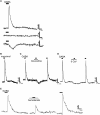The role of GABA in the regulation of GnRH neurons
- PMID: 25506316
- PMCID: PMC4246667
- DOI: 10.3389/fnins.2014.00387
The role of GABA in the regulation of GnRH neurons
Abstract
Gonadotropin-releasing hormone (GnRH) neurons form the final common pathway for the central regulation of reproduction. Gamma-amino butyric acid (GABA) has long been implicated as one of the major players in the regulation of GnRH neurons. Although GABA is typically an inhibitory neurotransmitter in the mature adult central nervous system, most mature GnRH neurons show the unusual characteristic of being excited by GABA. While many reports have provided much insight into the contribution of GABA to the activity of GnRH neurons, the precise physiological role of the excitatory action of GABA on GnRH neurons remains elusive. This brief review presents the current knowledge of the role of GABA signaling in GnRH neuronal activity. We also discuss the modulation of GABA signaling by neurotransmitters and neuromodulators and the functional consequence of GABAergic inputs to GnRH neurons in both the physiology and pathology of reproduction.
Keywords: GABA; GnRH neuron; KCC2; LH surge; NKCC1.
Figures


Similar articles
-
Sexually dimorphic modulation of GABA(A) receptor currents by melatonin in rat gonadotropin-releasing hormone neurons.J Physiol Sci. 2008 Oct;58(5):317-22. doi: 10.2170/physiolsci.RP006208. Epub 2008 Oct 7. J Physiol Sci. 2008. PMID: 18834560
-
Dominant Neuropeptide Cotransmission in Kisspeptin-GABA Regulation of GnRH Neuron Firing Driving Ovulation.J Neurosci. 2018 Jul 11;38(28):6310-6322. doi: 10.1523/JNEUROSCI.0658-18.2018. Epub 2018 Jun 13. J Neurosci. 2018. PMID: 29899026 Free PMC article.
-
Prenatal Testosterone Exposure Alters GABAergic Synaptic Inputs to GnRH and KNDy Neurons in a Sheep Model of Polycystic Ovarian Syndrome.Endocrinology. 2019 Nov 1;160(11):2529-2542. doi: 10.1210/en.2019-00137. Endocrinology. 2019. PMID: 31415088 Free PMC article.
-
GABAergic regulation of the HPA and HPG axes and the impact of stress on reproductive function.J Steroid Biochem Mol Biol. 2016 Jun;160:196-203. doi: 10.1016/j.jsbmb.2015.11.019. Epub 2015 Dec 9. J Steroid Biochem Mol Biol. 2016. PMID: 26690789 Free PMC article. Review.
-
Modulation of Gonadotropin-Releasing Hormone Neuron Activity and Secretion in Mice by Non-peptide Neurotransmitters, Gasotransmitters, and Gliotransmitters.Front Endocrinol (Lausanne). 2019 May 22;10:329. doi: 10.3389/fendo.2019.00329. eCollection 2019. Front Endocrinol (Lausanne). 2019. PMID: 31178828 Free PMC article. Review.
Cited by
-
Meta-Analysis of Heifer Traits Identified Reproductive Pathways in Bos indicus Cattle.Genes (Basel). 2021 May 18;12(5):768. doi: 10.3390/genes12050768. Genes (Basel). 2021. PMID: 34069992 Free PMC article.
-
Regulation of the gonadotropin-releasing hormone neuron during stress.J Neuroendocrinol. 2022 May;34(5):e13098. doi: 10.1111/jne.13098. Epub 2022 Feb 6. J Neuroendocrinol. 2022. PMID: 35128742 Free PMC article. Review.
-
A high plane of nutrition during early life alters the hypothalamic transcriptome of heifer calves.Sci Rep. 2021 Jul 7;11(1):13978. doi: 10.1038/s41598-021-93080-4. Sci Rep. 2021. PMID: 34234169 Free PMC article.
-
Huyang Yangkun Formula Enhances Ovarian Function and Delays Reproductive Aging by Influencing Hypothalamic GnRH/LH Pulse Release Through GAT-1/GABA/GABAAR2.Drug Des Devel Ther. 2025 Apr 9;19:2677-2691. doi: 10.2147/DDDT.S504610. eCollection 2025. Drug Des Devel Ther. 2025. PMID: 40226128 Free PMC article.
-
Photoperiodic Changes in Both Hypothalamus Neurotransmitters and Circulating Gonadal Steroids Metabolomic Profiles in Relation to Seasonal Reproduction in Male Quail.Front Physiol. 2022 Mar 25;13:824228. doi: 10.3389/fphys.2022.824228. eCollection 2022. Front Physiol. 2022. PMID: 35399254 Free PMC article.
References
Publication types
LinkOut - more resources
Full Text Sources
Other Literature Sources

